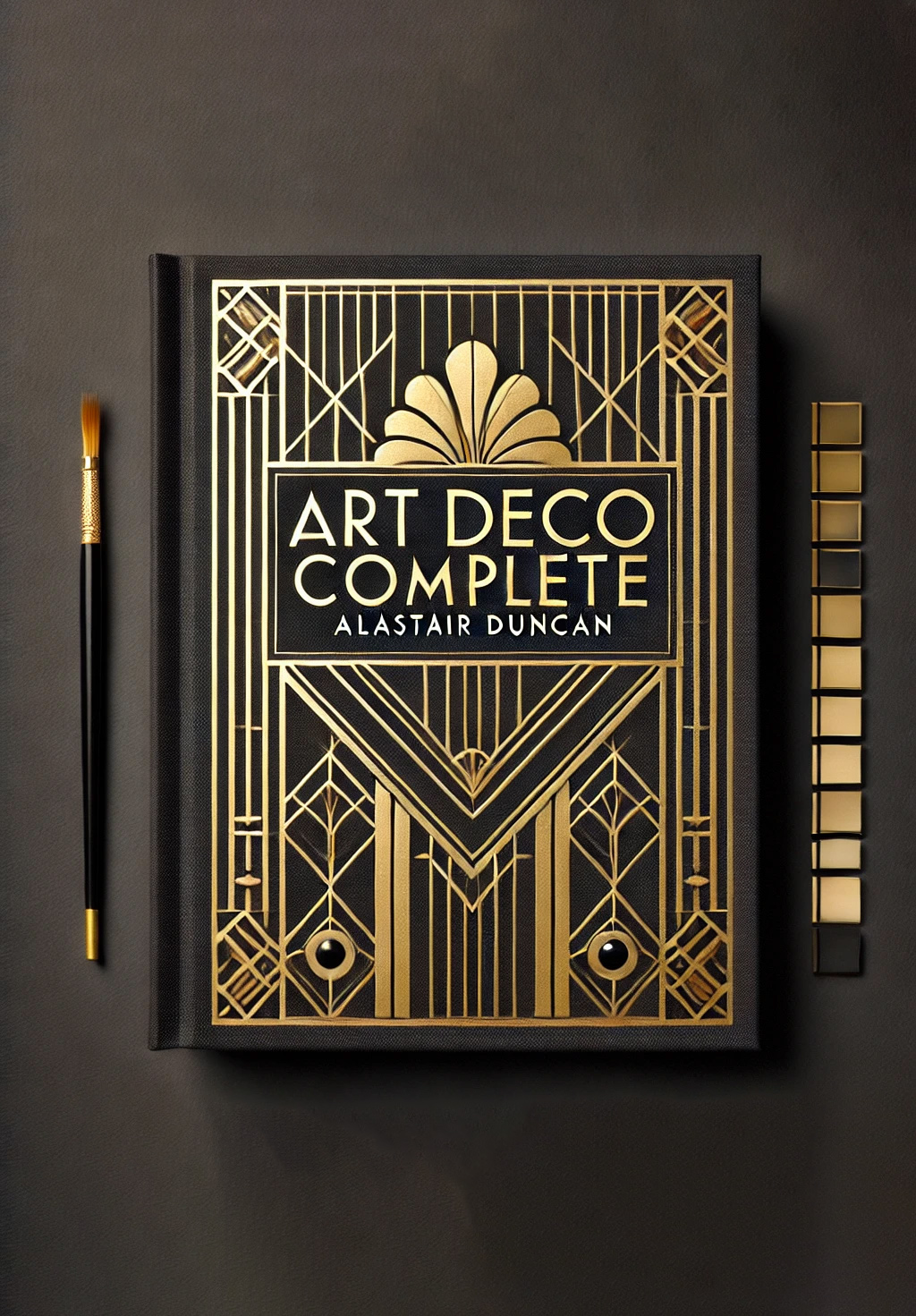The Rise of Art Deco:
Elegance in the Machine Age
Made for
Art Deco Lover • Elegant Level Designer
Level
Beginner & Advanced
Time
Minutes
1
Origins of Art Deco:
From Paris to Global Phenomenon
Art Deco was born in the aftermath of World War I, during a time when the world was eager for innovation and optimism. This new artistic movement stood in sharp contrast to the war’s hardships, embracing modernity, luxury, and progress. Its formal introduction came with the 1925 Exposition Internationale des Arts Décoratifs et Industriels Modernes in Paris, an exhibition that celebrated cutting-edge design and craftsmanship.
A Style Rooted in Change
The foundation of Art Deco was a response to the dramatic shifts in society and technology. Unlike its predecessor, Art Nouveau, which favored flowing lines and nature-inspired motifs, Art Deco embraced bold geometry, symmetry, and a sharper aesthetic. This new style reflected the machine age, where functionality and sleekness were paramount.
Paris: The Epicenter of Elegance
Paris served as the heart of the Art Deco movement, where artists and designers gathered to explore new ideas. The city was a melting pot of influences, from Egyptian motifs inspired by the discovery of Tutankhamun’s tomb to African tribal art and Japanese minimalism. These diverse elements fused to create a style that was exotic yet modern, resonating across different cultures.
A Marriage of Tradition and Technology
One of Art Deco’s defining characteristics was its use of innovative materials like steel, glass, and concrete, paired with luxurious finishes such as gold, lacquer, and marble. This balance between industrial efficiency and artisanal elegance made the style versatile. It could adorn the facades of grand skyscrapers while also appearing in everyday objects like furniture and jewelry.
A Global Phenomenon
Though it began in Paris, Art Deco quickly spread worldwide. Cities like London and New York adopted the style, integrating it into everything from architecture to graphic design. In Miami Beach, pastel-colored Art Deco buildings became a hallmark of tropical modernity, while Shanghai incorporated the style into its urban transformation. Each region added its unique touch, making Art Deco a universal symbol of progress and sophistication.
1 / 3 Sections Read
2
Key Features:
Geometry, Luxury, and Modernity
Art Deco’s defining features set it apart as a style of bold innovation and timeless elegance. This chapter explores the visual language, materials, and motifs that made Art Deco a unique reflection of the Machine Age and the pursuit of glamour.
Geometry:
Order and Precision
At its heart, Art Deco is a celebration of geometry. Clean lines, sharp angles, and symmetrical patterns dominate its aesthetic. Rectangles, triangles, and stepped forms mirror the structured designs of modern skyscrapers, while circles and arcs add a sense of flow and movement. These shapes are often arranged in striking, repetitive patterns, creating visual harmony.
One of the most iconic motifs of Art Deco is the sunburst—an exuberant symbol of energy and optimism. Sunbursts appear in everything from building facades and stained glass windows to jewelry and furniture. Similarly, zigzags, chevrons, and stepped designs echo the industrial spirit of the era, evoking images of machinery, transportation, and speed.
Luxury:
Materials that Speak of Elegance
At its heart, Art Deco is a celebration of geometry. Clean lines, sharp angles, and symmetrical patterns dominate its aesthetic. Rectangles, triangles, and stepped forms mirror the structured designs of modern skyscrapers, while circles and arcs add a sense of flow and movement. These shapes are often arranged in striking, repetitive patterns, creating visual harmony.
One of the most iconic motifs of Art Deco is the sunburst—an exuberant symbol of energy and optimism. Sunbursts appear in everything from building facades and stained glass windows to jewelry and furniture. Similarly, zigzags, chevrons, and stepped designs echo the industrial spirit of the era, evoking images of machinery, transportation, and speed.
Modernity:
The Machine Age Meets Art
Art Deco was deeply influenced by the technological advancements of its time. The streamlined designs of trains, automobiles, and airplanes inspired a sense of movement and speed that found its way into the style. Architects adopted these ideas to create buildings that looked modern and futuristic, with smooth surfaces and minimal ornamentation.
The style’s embrace of modernity extended to mass production. While many pieces were handcrafted for the elite, others were designed for wider audiences, blending practicality with beauty. Art Deco thus became a bridge between the artisan traditions of the past and the industrial possibilities of the future.
Through its combination of bold geometry, luxurious materials, and a celebration of modernity, Art Deco became a style that resonated across all aspects of design, from towering skyscrapers to delicate jewelry. It captured the spirit of its time while remaining endlessly inspiring for generations to come.
2 / 3 Sections Read
3
Art Deco’s Impact on Fashion, Furniture, and Architecture
Art Deco’s influence extended far beyond galleries and exhibitions, transforming the worlds of fashion, furniture, and architecture. This chapter explores how the movement’s bold aesthetic shaped these domains, leaving a legacy that continues to inspire today.
Fashion:
Redefining Elegance
Art Deco revolutionized fashion, introducing designs that reflected the era’s modern sensibilities. Clothing moved away from the intricate frills and corsets of the previous century, embracing sleek, linear silhouettes. Designers like Coco Chanel and Jean Patou championed simplicity and functionality, aligning with Deco’s geometric aesthetic.
Accessories became bold statements. Jewelry featured angular shapes, vibrant gemstones, and striking contrasts—diamonds paired with onyx, jade, or coral. The influence of exotic cultures, from Egyptian motifs to tribal patterns, added a dramatic flair. Evening wear sparkled with sequins and beads, mirroring the shimmering lights of Art Deco’s architectural marvels.
Furniture:
A Union of Form and Function
Art Deco furniture combined practicality with artistry, creating pieces that were as functional as they were visually striking. Designers like Émile-Jacques Ruhlmann and Donald Deskey embraced high-quality materials like exotic woods, mother-of-pearl, and polished metals to craft luxurious yet modern designs.
Key features included streamlined shapes, stepped patterns, and lacquered finishes. Furniture was often embellished with geometric inlays or gilded accents, reflecting the movement’s love for symmetry and glamour. Whether in private homes or public spaces, Deco furniture added a sense of sophistication and progress.
Architecture:
Towers of Innovation
Perhaps the most iconic expression of Art Deco is its architecture. Skyscrapers like the Chrysler Building and Empire State Building in New York epitomize the style’s grandeur and its celebration of modernity. These buildings featured stepped facades, sleek spires, and intricate decorative elements inspired by sunbursts, machinery, and nature.
Beyond skyscrapers, Art Deco shaped theaters, hotels, and even factories. The streamlined designs of Miami’s pastel-colored Deco district brought glamour to tropical settings, while urban cinemas, like those in London, combined functionality with eye-catching detail. The use of innovative materials, from reinforced concrete to polished steel, ensured that these structures were both durable and dazzling.
Art Deco’s reach into fashion, furniture, and architecture created a cohesive aesthetic that defined an era. Its ability to marry elegance with modernity left an indelible mark on the 20th century and continues to inspire designers, architects, and artists today.
3 / 3 Sections Read
Closing Thought
Art Deco, born in Paris after World War I, became a global symbol of modernity and elegance. Its bold geometry, luxurious materials, and embrace of technology revolutionized fashion, furniture, and architecture. The style bridged traditional craftsmanship with the innovation of the Machine Age, leaving a legacy of timeless sophistication.
What you have learnt
1. Origins: Art Deco emerged in Paris during the 1920s, influenced by cultural shifts, technological advancements, and global artistic traditions.
2. Defining Features: Bold geometric patterns, luxurious materials like chrome and lacquer, and a focus on symmetry and modernity.
3. Fashion: Redefined elegance with streamlined clothing, bold accessories, and exotic influences.
4. Furniture: Blended functionality and art with sleek designs, exotic materials, and geometric patterns.
5. Architecture: Iconic skyscrapers, theaters, and public buildings with innovative designs and intricate motifs.
Congratulations!
You have read the entire chapter!

Are you interested in the extensive and brilliant period of Art Deco from 1920 to 1930 in America and Europe? Then we warmly recommend the following book, which also inspired us to create this title.
Art Deco Complete:
The Definitive Guide to the Decorative Arts of the 1920s and 1930s
By Alastair Duncan
Your support means the world to us. By shopping via the links we share, you contribute to our vision while incurring no extra cost. Thank you for fueling our creativity!
